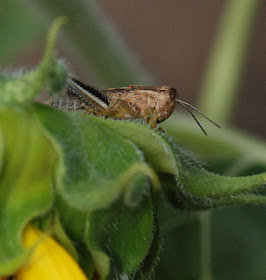The next stop on my walkabout was the volunteer sunflower that I have been keeping an eye on for several days now. I posted about it a few days ago; it's been interesting to see how it changes.
Far from becoming less attractive to other species, this sunflower blossom seems to have more visitors each time I check on it, even if it isn't as pretty to the human eye as it was when it first opened. As I walked up, I first noticed a trio of insects sitting on the top of the flower: a seven-spotted ladybug beetle, and two grasshoppers....
The brown grasshopper is a nymph (not an adult - note the lack of wings) and, if I don't miss my guess, the tiny red spot just under the tip of his pronotum (the shield-like structure over the back of his neck) is a red mite, hitching a ride and probably a meal. Even insects get the equivalent of ticks! Just think, too, how big that grasshopper seems to that mite!
The second grasshopper, a green one, is a species I hadn't noticed before this year. I've been seeing a lot of these classy grasshoppers around recently, though.
When I looked it up, this is known as a sunflower grasshopper, a showy grasshopper or a western green grasshopper...among other common names. The scientific name is Hesperotettix speciosus. I like its soft green coloring, its white "freckles" and its pink highlights. If I've got to have grasshoppers around, at least this one is pretty.
The seven-spotted ladybug beetle, Coccinella septempunctata, is actually a European ladybug that was introduced to the U.S. several times between 1956 and 1973 to fight aphids. It wasn't until 1973 that a population finally established itself here. Now it has spread throughout North America and is quite common.
When I bent over to look into the face of the sunflower, I felt like I'd really hit the jackpot - 5 little metallic bees, a crab spider, and a yellow-spotted buprestid beetle!
Can you see them all?
The yellow spotted buprestid beetle is on the left, right by the petals....
the crab spider at about 2 o'clock, actually on one of the petals....
and the 5 metallic bees are scattered across the center, feeding on nectar and pollen. Here are 3 of them, magnified a bit to be easier to see....
A total of 10 insects utilizing one 4" flower! Talk about a garden that's alive! My garden will never win the Good Housekeeping Seal of Approval, but I'd rather have my hole-filled (holy!) leaves and somewhat tattered, but well used, blooms than all the picture perfect "glory" that can be beamed at me through glamorous magazine photos any day.
Anyway, enough of that! On to the next stop on our walkabout....






Love it! I am impressed at your grasshopper photos. They never sit still long enough for me to capture them.
ReplyDeleteWe have some neon green grasshoppers too. .Loved the life on your sunflower!! I been noticing how many critters are among my purple coneflower stand. .It is the first year that the flowers have really filled in and taken a lot of space in the garden. .and it happens to be right off the sidewalk I use to get to hubby's shop or my car. .It seems to ALWAYS be a busy little restaurant for LOTS of different buggy varieties! Thanks for sharing! I always learn something when I am here!
ReplyDeleteKarin, I think we just have so many of them this year that they're becoming insolent! ("I DARE you to do something about us, lady!") LOL!
ReplyDeleteMelanie, Aren't the purple coneflowers amazing? The variety and number of insects and other critters I find on them is amazing!
ReplyDeleteWow...this is really an educational gardening blog! Thank you for identifying so many critters and giving me a more benevolent attitude about grasshoppers. I've been really upset with them of late, as they are chewing the beauty to bits. Just have to appreciate all aspects of the garden, though!
ReplyDeleteThanks, Carla. I can't say I'm thrilled about the number of grasshoppers we have here this year, but I know that most of what they chew on won't be killed. Glad you stopped by!
ReplyDelete